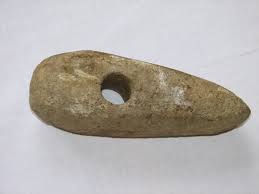The battle axes found in river Trent near of the Worksop, Nottinghamshire and it date back to the late neolithic and early Bronze Age (C2200-1900BC).
A battle axe is an axe that specifically designed for combat. Battle-axes were specialised versions of utility axes. Many were suitable for use in one hand, while others were larger and were deployed two-handed. The iron axes created with either one sharpens side or both sharpen sides.
A ground stone battle axe, probably of Scandinavian origin and dating from the Neolithic period. The axe, which survives intact, is of flattened-oval section, tapering to a wedge-shaped, downward-curving blade. The cylindrical socket is located close to the butt of the axe, where there is a rearward, hammer-like projection of circular section. The tool has been made from a medium-textured grey stone with a strand-like structure. Stone (diorite) perforated waisted battle axe, lozenge-shaped in plan, sub-rectangular in profile and oval in section, with a faceted butt end and an expanded blade.
Battle Axe (Stone) Battle Axe (Iron)


